Paul Lee
and Gus Van Sant in conversation upon the occasion of Tambourine Heart, Lee’s solo exhibition at Adams and Ollman
Gus Van Sant: Have you been locked down in New York?
Paul Lee: Yes, pretty much. It's just the studio and home. Being at the studio every day without really any distractions has been a positive part of Covid. To be able to be in New York and just focus—they don't really go that well together. I've been trying to make the most of it.
“That’s where I made my first big film, and I just stayed there. There were more stories to tell from Portland.”
—Gus Van Sant
GVS: You're having a show in Portland in April?
PL: Yes, at Adams and Ollman. When I first spoke with Amy about the show, I had a pile of collages I was making that I felt like creating something new out of broken things. Portland was at the center of the protests, and the work reflected the urgency of the times. It felt like a fitting place to show the work.
Do you still live in Portland?
GVS: I don't at the moment. It has been about two or three years since I have had a place there, but I feel attached to it.
PL: A lot of your films take place there.
GVS: That's where I made my first big film, and I just stayed there. There were more stories to tell from Portland.
Have all of the works that you are going to show in Portland been selected?
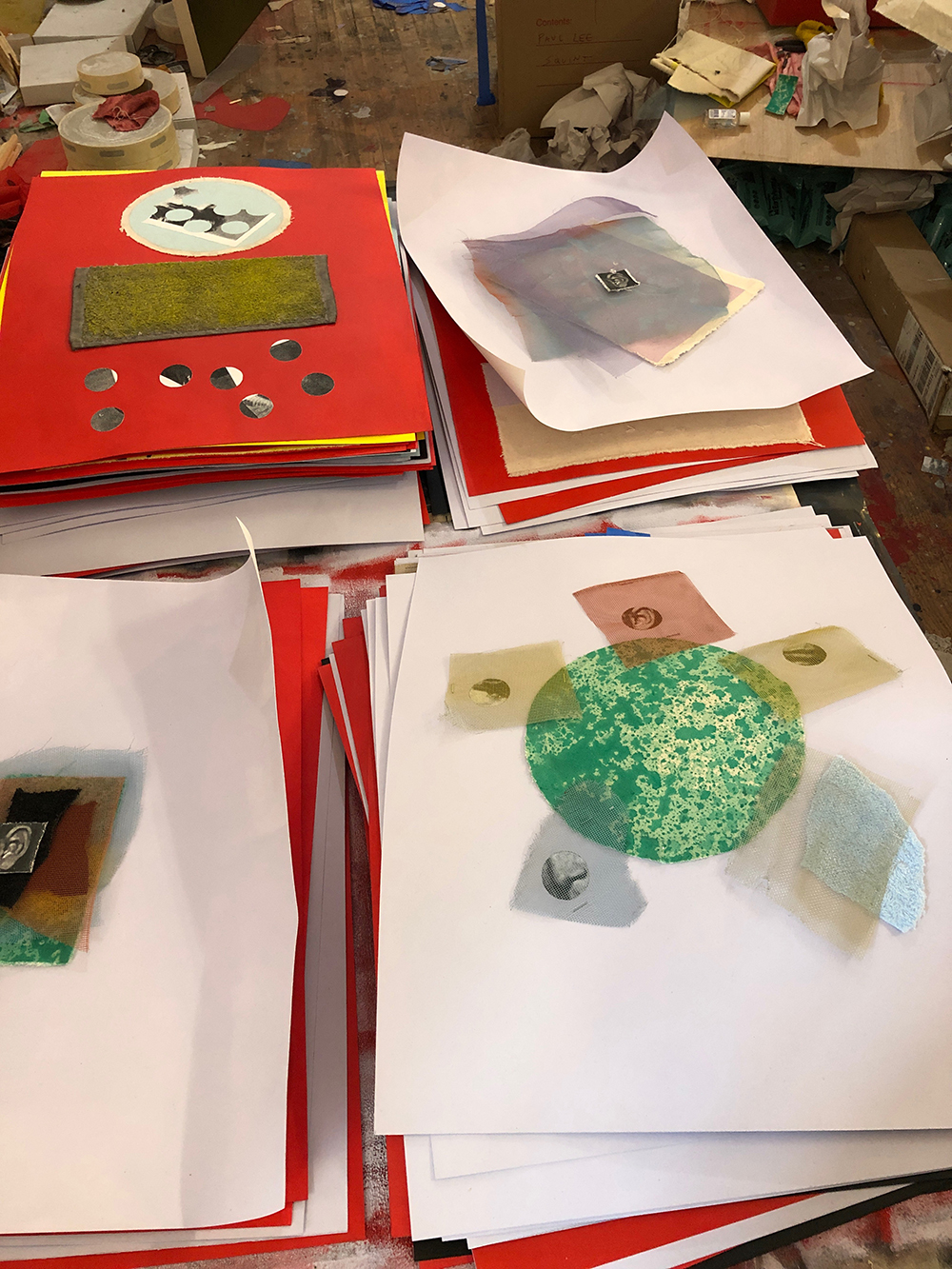
collages in Paul Lee’s studio
PL: I made about 100 collages, and then we made a selection from there. I'm still working on them. It's a freeing gesture to collage—pulling things from all around the studio. There'd be a pile of materials, and it would inspire a collage. I can discover new things and ideas.
GVS: Have you not worked that way before?
PL: When I first started showing my work, I made little collages on 8 ½ x 11-inch paper in my bedroom in the city, which was tiny. I used the space I had, and it was a good way to work without making too much of a mess and without having a studio. When you can't go to the art supply store, you have to use what is on hand. I have used images of faces that I found on the Internet. And the face I used in all the collages is the same face I've used on the can sculptures.
GVS: Yes, I have seen many of them. I've seen all the ones that you had shown in the Stonewall slideshow. So I saw a lot of those and some with that same face. Where is that image from?
PL: It's from a '50s naturalist magazine. I bought it when I first came to New York in a book shop on Hudson Street with a little section downstairs with vintage erotic magazines. I've always had that magazine, and in the spread, his face was next to another man's face. I've used both of them together before. He is almost like an actor that appears throughout the work, and I haven't come to understand completely why I keep using that face or why it stays with me.
I was thinking of it in terms of what you're doing with your movies. How often there's an attractive man at the center of the film, and you follow that character throughout the film. You place the viewer in the shoes of that character—the idea of incriminating the viewer in the situation. It's a way of queering the viewer. The viewer becomes gay.
“I used a little square stencil that framed the mouth to the nose to the eye to the ear and then back around again, joining all the senses together. The only sense that was missing was touch. The image was interacting with me through the absence of touch, and I was its presence.”
—Paul Lee
GVS: Lead characters are how you bring the viewer along. You usually have a lead character who is alluring in some way, whether they are men or women. You intend them to be an anchor. And sometimes movie stars and actors generally skew to the more attractive side, which is not necessarily an honest thing. But I think it's also the way I understand how the movie business came to be. Movies were shown in nickelodeons which were in malls as a distraction for shoppers in the early 1900s. The women who frequented these arcades started asking about the characters in these films they were watching. The people running the nickelodeon shops didn't know what they were talking about. And the women said no, the actor! Are there any more pieces with this particular actor? Like a Rudolph Valentino style actor. The people making the movies started to get the idea, and they made a few more with the same actor who then became a bigger and bigger personality, and then that actor became bigger and bigger. The filmmakers discovered that there was value in the idea of a lead character. And so they hired Chaplin or John Barrymore.
There's a film, Death in Buenos Aires, I watched on a gay channel called QTTV that I just discovered. The lead character is a Hitchcockian figure. You're not sure if he is bad and he is very mysterious. He is also extremely good-looking, so I clicked on that particular film. It's all about his character and people reacting to him. He was sort of a Brad Pitt type of character. I am sure that cinema will morph into something else that won't depend upon this kind of lead character somewhere along the line.
The picture in your work...I didn't know if it was a man or a woman.
PL: Oh wow, that's interesting, because he is very pretty. I've been considering what it means that this character is a real-life person, yet they're moving through the work. I used a little square stencil that framed the mouth to the nose to the eye to the ear and then back around again, joining all the senses together. The only sense that was missing was touch. The image was interacting with me through the absence of touch, and I was its presence. The idea that, as a gay person navigating the world, the things that come naturally can be compromised. I've since become really focused on the ear because it ties back to the tambourines. The ear becomes the only indicator of the figure because there's never sound in an image. It's interesting to locate a presence through the absence.
GVS: So the tambourines make noise?
PL: Yeah, it was something to be touched, but you could only think about touching it.
GVS: You've made many pieces with tambourines. Do they make noise?
PL: When you drop them they do! Sometimes in my studio, if the windows open and they are on the wall, there'll be a little jingling sound in the studio. Sometimes I'll be walking around the studio, I'll tread on one, or one will fall down. They make themselves known in that way.
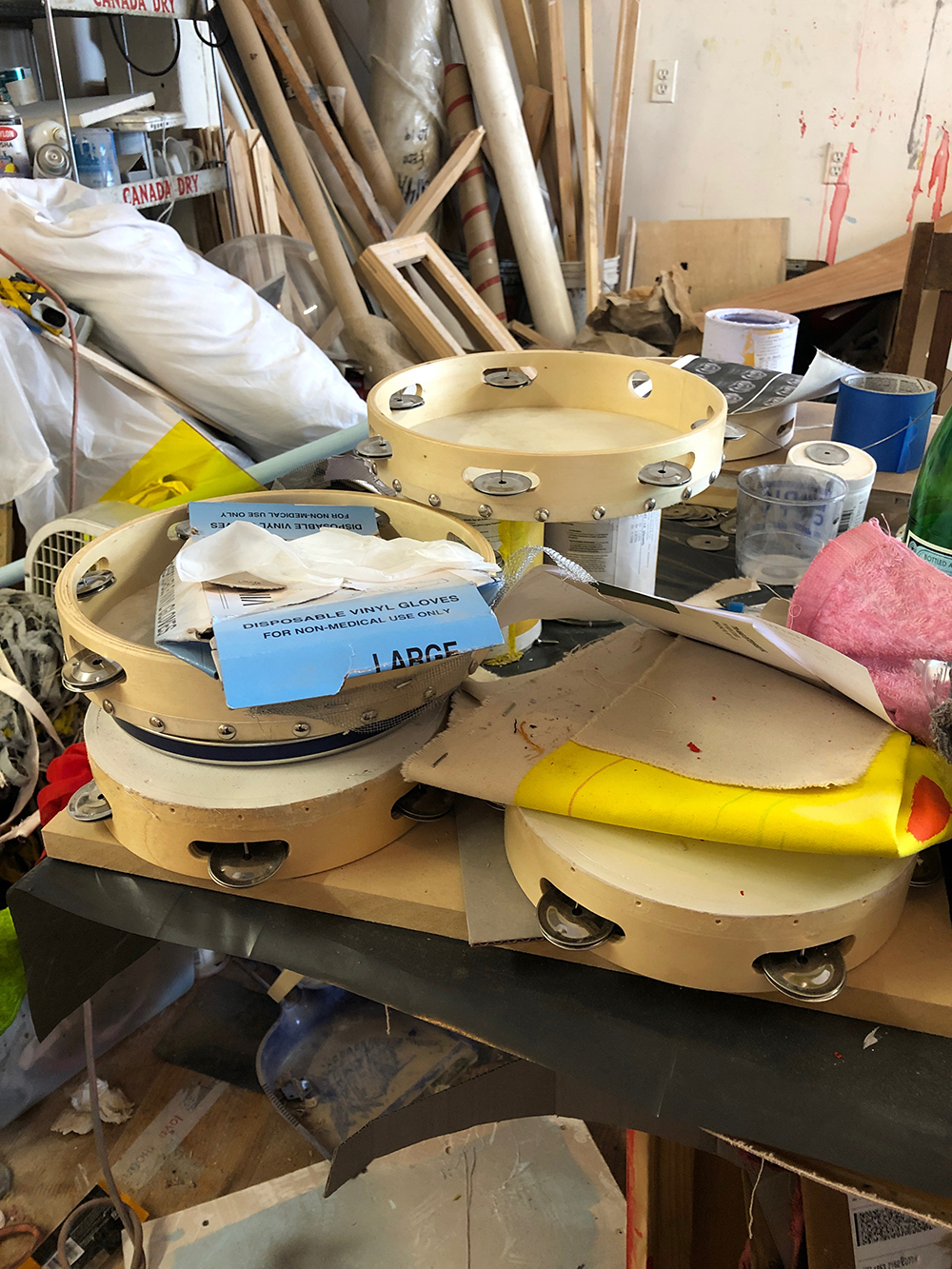
tambourines in Paul Lee’s studio
GVS: Is the tambourine a particular size?
PL: There are two sizes I use: a 10-inch tambourine and an 8-inch tambourine. They exist in their own bodies of work. I think of the small one as a younger self because I think of them as bodies. The bigger tambourine is on the larger scale painting, and had a different, more confident presence. Sometimes I would put them both in one work, informing the conversation between the two tambourines. It's been interesting to use a musical instrument and not have any music.
You make music, as well?
GVS: I have for a long time. I've played the guitar when I've recorded music. When I was in New York working in an ad agency in 1980, we did radio commercials and some film commercials, but I was always relegated to radio commercials. We did some in-house radio commercials, and the sound recordist in that agency searching said they had just developed a Tascam four-track recorder, and people were using it. By then, Bruce Springsteen had recorded his album "Nebraska," which I bought. I bought a four-track recorder for $1000. It was beautiful, and I intended to use it for soundtracks.
I mixed Mala Noche on it. But before I got to that step, I realized that you could make a pretty good rock and roll sound with a bit of echo. So I did these kinds of funny rock and roll sounds, and I made about eight different albums. I became obsessed with recording and became really good at mixing the sound.
“I use the screen as an object one looks through to create a physicality to seeing, which sums up many of my ideas.”
PL: When I started making these collages, the little circles were drawn from the tambourine bell. The idea that the body existed, represented by the bells and the sounds, was part of its physicality. It's another way of using the absence of sound—creating a space through absence seems to be a theme of what I am doing—for example, one work in the show with just the ear of my actor. I've put a screen over top of it. I use the screen as an object one looks through to create a physicality to seeing, which sums up many of my ideas. The screen has been a new material that has helped to create volume.
GVS: When did you start using screens?
PL: Since the lockdown, actually. I had screens in the studio forever, but I'd never used them before. Are you working on paintings at the moment? I saw some of your paintings online, and they look beautiful.
![]()
Gus Van Sant shows Paul Lee his painting.
GVS: Here's one (GSV shows PL a painting). It's the Mona Lisa. There are many more Mona Lisas... here's another.
PL: Is there a particular attachment to the Mona Lisa?
GVS: At first, I was thinking of it as a subject. It was the most well-known painting, and using it was a way to have a subject and yet not have a subject at the same time.
PL: So it's almost like it becomes the Mona Lisa's gaze. You don't meet it, but the idea of gazing is there. It's definitely quite different from the work I have seen of yours. It's more conceptual.
GVS: There's a much more conceptual attitude, and it also has more comedy.
PL: Comedy is always good.
GVS: Your stuff is quite comical as well.
PL: Humor is a perfect way to let people in. It opens people up. You are vulnerable when you are laughing, right?
GVS: Can you talk about some of your favorite artists?
PL: I recently learned about Frederick Weston, who died just last year. He was unrecognized for a long time. I loved his show at Gordon Robichaux— it reminded me of barbershops where they always had collages of different haircuts. Weston collected all different kinds of pictures of men. The exhibition included binders containing all the other images he had collected. On the walls were collages he had made from these images, including these scuba divers made up of all different faces all over the body. That was really beautiful.
Are there any artists that you are following?
GVS: In the last few years, Paul McCarthy.
I think the first works I saw were in New York in '95. His early performances were extreme and also comical. He told a story once where he was doing this piece, which generally was like in a small classroom size space with maybe twenty people in the room, and said everyone left the performance while he was still performing. Everyone—one by one—had left, and the room was empty, but he continued the performance. Then he saw people coming back and, thought Oh, they've come back, but then he realized it was the police!
His work is very extreme. He had a big show in Paris where he made a very large butt plug as a Christmas tree. It became a big problem, and they had to move it.
How do chance and accidents work for you?
PL: I'm allowing new things to happen in the collages. I have a language of materials—soda cans, towels, screens, tambourines. Scale is really important to me. The sizes of the paintings were always dependent upon the size of the tambourine. I think that that's why I keep my studio a mess as well, in a way, because you just see things as they are, and it becomes an organic space. I think chance is definitely important.
GVS: Have you worked with video as a sculptural form?
![]()
![]()
stills, Paul Lee, Red Cigarette, 2013
PL: I've made small videos. I made a video in Central Park in the brambles. It was pouring rain and I was filming the raindrops falling in the puddles and breaking up the reflected image. In Reservoir, 2007, I filmed a photocopier spitting out an image of the sea. The photocopy tray moved up and down like it was mimicking how the sea moves, and the waves were coming out and stacking up. It was like watching someone daydream.
And you saw Red Cigarette, 2013, which was filmed under a flashing red light. I made a blue version, as well. I was pouring water from a watering can over the tambourine bells hanging down, and the tambourines were rotating. It was the closest I've come to making a narrative film.
GVS: How long do you work on a piece?
PL: It depends. With the collages, I can make one in two minutes, but it will take a few days of leaving the elements sitting around and going back, and then I'll stack them up, and then I'll take the stack apart, and then it becomes something else, or it might change.
“Yes, the problematic works become much more interesting.”
GVS: A strange experience that I have is that I will make many pieces that are made in a similar way with similar materials, and yet, there will be ones you think are very successful and ones that you kind of put aside. And then later, you'll see the ones that you set aside were actually much better.
PL: The problematic works.
GVS: Yes, the problematic works become much more interesting. The photographer Harry Callahan would take photographs and print them, and then he would wait three years before he showed anyone.
PL: I've been living with a lot of this new stuff longer than I usually do because I would have to show work at art fairs. Another reason the lockdown has been really good—living with work has been really good. I guess that when you make films, you get to live with the script, but then the film happens in a short period. It's a very different kind of experience.
GVS: A similar thing happens in a film where you're arranging a scene, and you start the scene, the actors do their thing, and then you say cut, and they relax. And they do something more naturally because we're no longer shooting. Sometimes the camera is still rolling, and that's the part you really want—that kind of natural movement which doesn't exist in the actual scene.
PL: Do you ever leave the camera rolling?
GVS: I've tried to do that. Working with young actors like we did a couple times— like Elephant in particular, they weren't actors. You couldn't control them like an ordinary actor; everyone was improvising. They were the same off-screen as they were on-screen. Clint Eastwood will roll without using the slate, and he'll somehow signal the background to move and so forth to get that quality, the natural motion. But it's hard. I do it more by just not caring so much. I give less direction, and it makes it more lifelike.
PL: And maybe it forces the people you're working with to think harder about it if they're not so directed. What was it like when you put out My Own Private Idaho? I felt like when that was put out, there weren't as many gay films like that. It felt very much like you are seeing gay things in a movie. Was there any sort of pushback?
GVS: Idaho was made in 1991. By then, there had been lots of different types of gay films. There had been festivals for gay films since the '70s. I was trying to capture something that existed in Portland — homeless kids were living in abandoned hotels as rent boys, but as it was written, they were straight in the original script. There was this moment—the campfire moment in the movie—where one boy asked another if he would ever fool around. They were bored, and they wanted something to do. And that's how that scene was written. And then, when River was acting it, he had a friend that was an Act Up member, and he really wanted River to play a gay character and not a traditional rent boy, a straight character. I said, "Yeah, sure, if you want to do that, that's fantastic," so we went in that direction. That added a whole element to his character that wouldn't have been there.
![]()
still, Gus Van Sant, My Own Private Idaho, 1991
PL: I love the magazine scene in that movie as well, where the magazines are talking to each other. It's a great scene.
Gus Van Sant (b. 1952, Louisville, KY), admired internationally as a filmmaker, painter, photographer, and musician, received his BFA from the Rhode Island School of Design in Providence in 1975. Since that time his studio painting practice has moved in and out of the foreground of a multi-disciplinary career, becoming a priority again over recent years. Van Sant’s work in different mediums is united by a single overarching interest in portraying people on the fringes of society.
Van Sant’s work has been the subject of solo exhibitions at the Musée de l’Elysée in Lausanne, Switzerland, Le Case d’Arte in Milan, Italy, and the Jordan Schnitzer Museum of Art at the University of Oregon in Eugene, among others. He has participated in numerous group exhibitions since the 1980s, presenting drawings, paintings, photographs, video works, and writing. Among Van Sant’s many internationally acclaimed feature films are Milk (2008); Elephant (2003); Good Will Hunting (1997); My Own Private Idaho (1991); and Drugstore Cowboy (1989).
Van Sant lives and works in Los Angeles, California.
“I use the screen as an object one looks through to create a physicality to seeing, which sums up many of my ideas.”
—Paul Lee
PL: When I started making these collages, the little circles were drawn from the tambourine bell. The idea that the body existed, represented by the bells and the sounds, was part of its physicality. It's another way of using the absence of sound—creating a space through absence seems to be a theme of what I am doing—for example, one work in the show with just the ear of my actor. I've put a screen over top of it. I use the screen as an object one looks through to create a physicality to seeing, which sums up many of my ideas. The screen has been a new material that has helped to create volume.
GVS: When did you start using screens?
PL: Since the lockdown, actually. I had screens in the studio forever, but I'd never used them before. Are you working on paintings at the moment? I saw some of your paintings online, and they look beautiful.

Gus Van Sant shows Paul Lee his painting.
GVS: Here's one (GSV shows PL a painting). It's the Mona Lisa. There are many more Mona Lisas... here's another.
PL: Is there a particular attachment to the Mona Lisa?
GVS: At first, I was thinking of it as a subject. It was the most well-known painting, and using it was a way to have a subject and yet not have a subject at the same time.
PL: So it's almost like it becomes the Mona Lisa's gaze. You don't meet it, but the idea of gazing is there. It's definitely quite different from the work I have seen of yours. It's more conceptual.
GVS: There's a much more conceptual attitude, and it also has more comedy.
PL: Comedy is always good.
GVS: Your stuff is quite comical as well.
PL: Humor is a perfect way to let people in. It opens people up. You are vulnerable when you are laughing, right?
GVS: Can you talk about some of your favorite artists?
PL: I recently learned about Frederick Weston, who died just last year. He was unrecognized for a long time. I loved his show at Gordon Robichaux— it reminded me of barbershops where they always had collages of different haircuts. Weston collected all different kinds of pictures of men. The exhibition included binders containing all the other images he had collected. On the walls were collages he had made from these images, including these scuba divers made up of all different faces all over the body. That was really beautiful.
Are there any artists that you are following?
GVS: In the last few years, Paul McCarthy.
I think the first works I saw were in New York in '95. His early performances were extreme and also comical. He told a story once where he was doing this piece, which generally was like in a small classroom size space with maybe twenty people in the room, and said everyone left the performance while he was still performing. Everyone—one by one—had left, and the room was empty, but he continued the performance. Then he saw people coming back and, thought Oh, they've come back, but then he realized it was the police!
His work is very extreme. He had a big show in Paris where he made a very large butt plug as a Christmas tree. It became a big problem, and they had to move it.
How do chance and accidents work for you?
PL: I'm allowing new things to happen in the collages. I have a language of materials—soda cans, towels, screens, tambourines. Scale is really important to me. The sizes of the paintings were always dependent upon the size of the tambourine. I think that that's why I keep my studio a mess as well, in a way, because you just see things as they are, and it becomes an organic space. I think chance is definitely important.
GVS: Have you worked with video as a sculptural form?
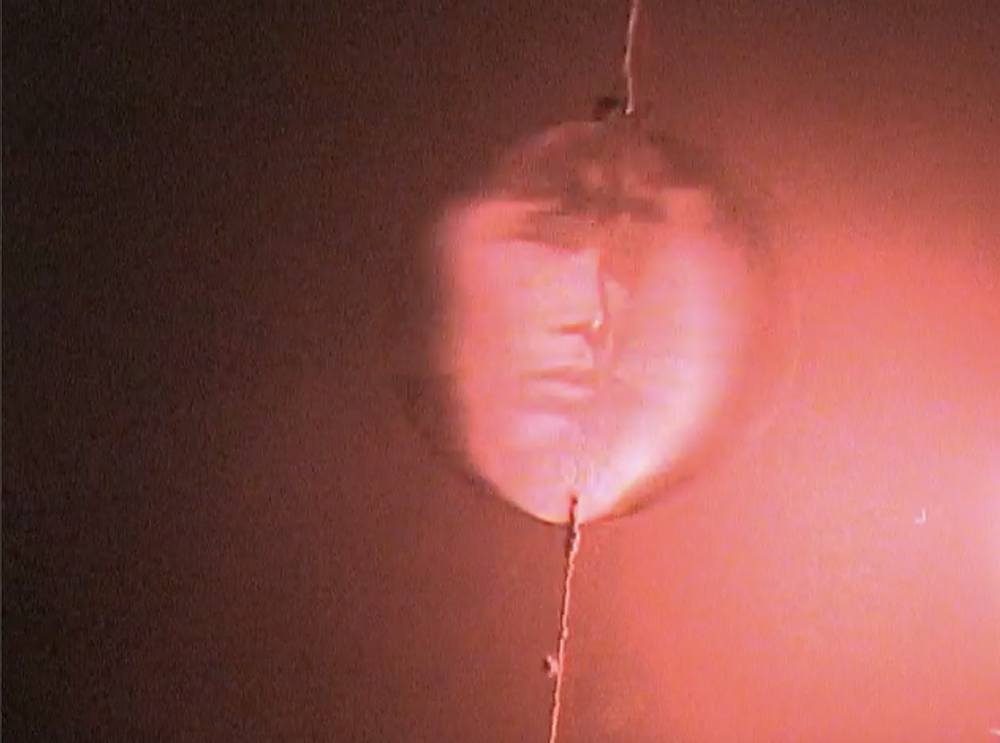
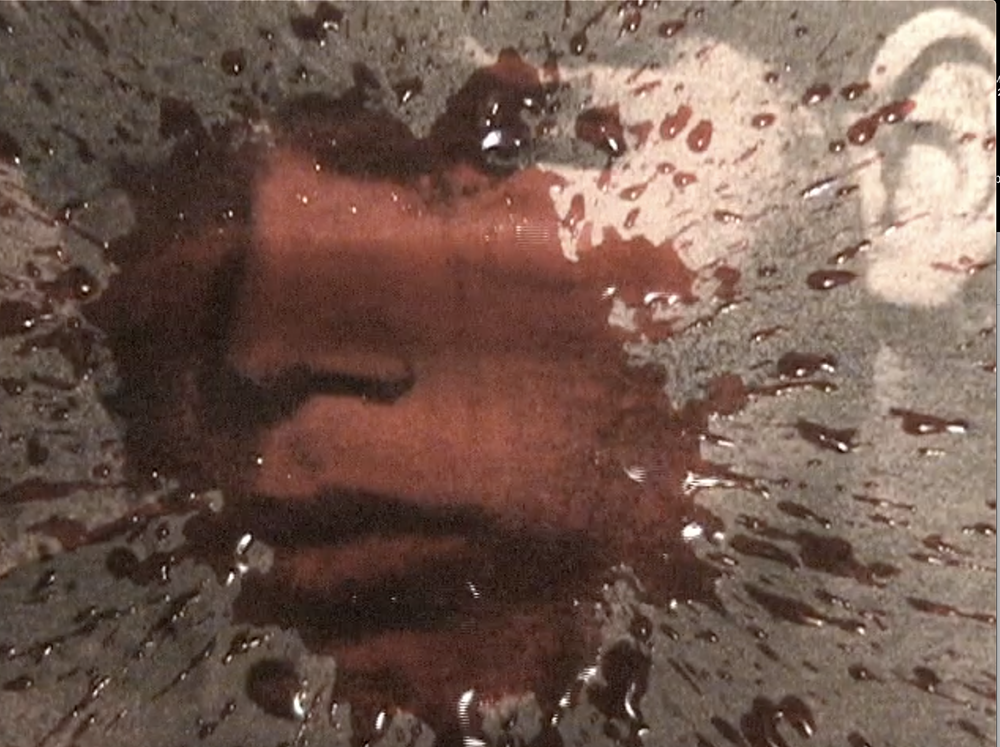
stills, Paul Lee, Red Cigarette, 2013
PL: I've made small videos. I made a video in Central Park in the brambles. It was pouring rain and I was filming the raindrops falling in the puddles and breaking up the reflected image. In Reservoir, 2007, I filmed a photocopier spitting out an image of the sea. The photocopy tray moved up and down like it was mimicking how the sea moves, and the waves were coming out and stacking up. It was like watching someone daydream.
And you saw Red Cigarette, 2013, which was filmed under a flashing red light. I made a blue version, as well. I was pouring water from a watering can over the tambourine bells hanging down, and the tambourines were rotating. It was the closest I've come to making a narrative film.
GVS: How long do you work on a piece?
PL: It depends. With the collages, I can make one in two minutes, but it will take a few days of leaving the elements sitting around and going back, and then I'll stack them up, and then I'll take the stack apart, and then it becomes something else, or it might change.
“Yes, the problematic works become much more interesting.”
—Gus Van Sant
GVS: A strange experience that I have is that I will make many pieces that are made in a similar way with similar materials, and yet, there will be ones you think are very successful and ones that you kind of put aside. And then later, you'll see the ones that you set aside were actually much better.
PL: The problematic works.
GVS: Yes, the problematic works become much more interesting. The photographer Harry Callahan would take photographs and print them, and then he would wait three years before he showed anyone.
PL: I've been living with a lot of this new stuff longer than I usually do because I would have to show work at art fairs. Another reason the lockdown has been really good—living with work has been really good. I guess that when you make films, you get to live with the script, but then the film happens in a short period. It's a very different kind of experience.
GVS: A similar thing happens in a film where you're arranging a scene, and you start the scene, the actors do their thing, and then you say cut, and they relax. And they do something more naturally because we're no longer shooting. Sometimes the camera is still rolling, and that's the part you really want—that kind of natural movement which doesn't exist in the actual scene.
PL: Do you ever leave the camera rolling?
GVS: I've tried to do that. Working with young actors like we did a couple times— like Elephant in particular, they weren't actors. You couldn't control them like an ordinary actor; everyone was improvising. They were the same off-screen as they were on-screen. Clint Eastwood will roll without using the slate, and he'll somehow signal the background to move and so forth to get that quality, the natural motion. But it's hard. I do it more by just not caring so much. I give less direction, and it makes it more lifelike.
PL: And maybe it forces the people you're working with to think harder about it if they're not so directed. What was it like when you put out My Own Private Idaho? I felt like when that was put out, there weren't as many gay films like that. It felt very much like you are seeing gay things in a movie. Was there any sort of pushback?
GVS: Idaho was made in 1991. By then, there had been lots of different types of gay films. There had been festivals for gay films since the '70s. I was trying to capture something that existed in Portland — homeless kids were living in abandoned hotels as rent boys, but as it was written, they were straight in the original script. There was this moment—the campfire moment in the movie—where one boy asked another if he would ever fool around. They were bored, and they wanted something to do. And that's how that scene was written. And then, when River was acting it, he had a friend that was an Act Up member, and he really wanted River to play a gay character and not a traditional rent boy, a straight character. I said, "Yeah, sure, if you want to do that, that's fantastic," so we went in that direction. That added a whole element to his character that wouldn't have been there.
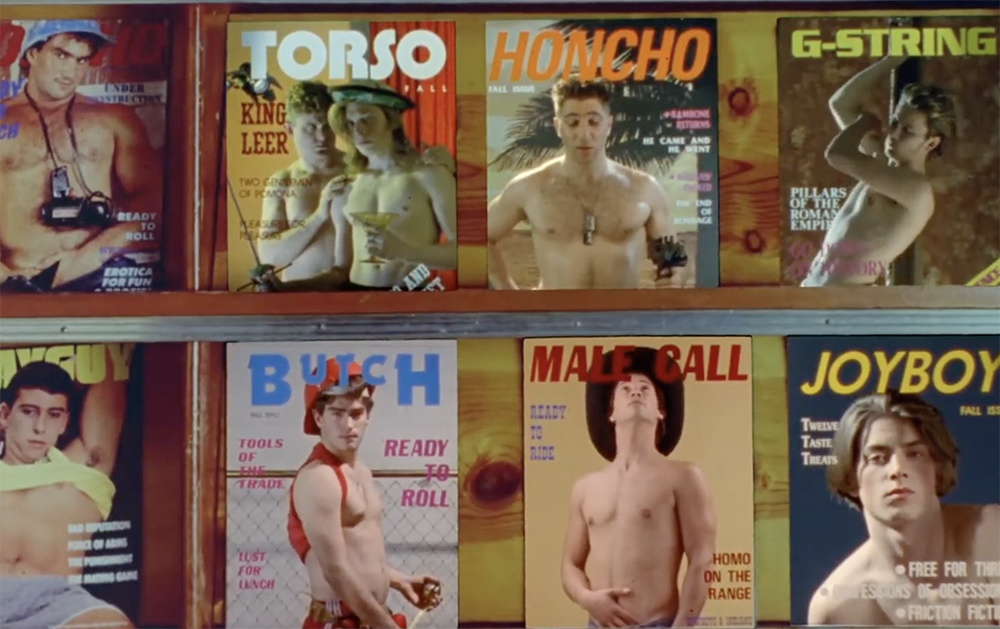
still, Gus Van Sant, My Own Private Idaho, 1991
PL: I love the magazine scene in that movie as well, where the magazines are talking to each other. It's a great scene.
Gus Van Sant (b. 1952, Louisville, KY), admired internationally as a filmmaker, painter, photographer, and musician, received his BFA from the Rhode Island School of Design in Providence in 1975. Since that time his studio painting practice has moved in and out of the foreground of a multi-disciplinary career, becoming a priority again over recent years. Van Sant’s work in different mediums is united by a single overarching interest in portraying people on the fringes of society.
Van Sant’s work has been the subject of solo exhibitions at the Musée de l’Elysée in Lausanne, Switzerland, Le Case d’Arte in Milan, Italy, and the Jordan Schnitzer Museum of Art at the University of Oregon in Eugene, among others. He has participated in numerous group exhibitions since the 1980s, presenting drawings, paintings, photographs, video works, and writing. Among Van Sant’s many internationally acclaimed feature films are Milk (2008); Elephant (2003); Good Will Hunting (1997); My Own Private Idaho (1991); and Drugstore Cowboy (1989).
Van Sant lives and works in Los Angeles, California.